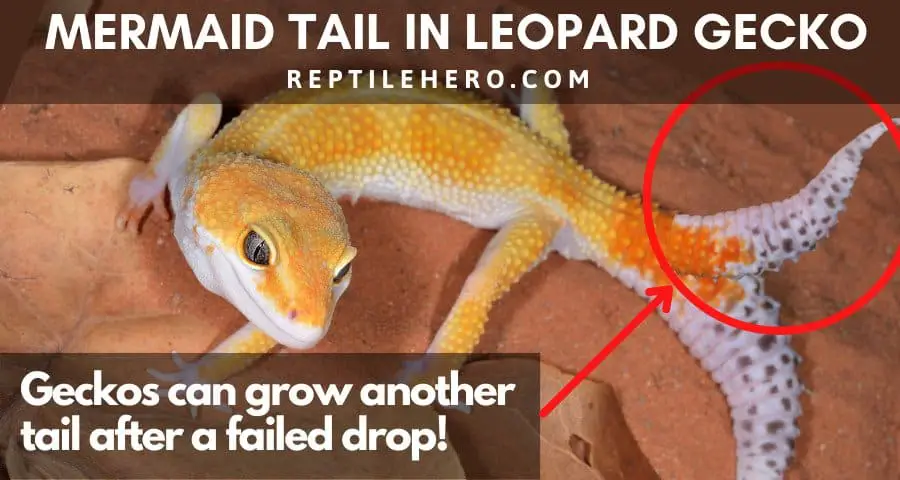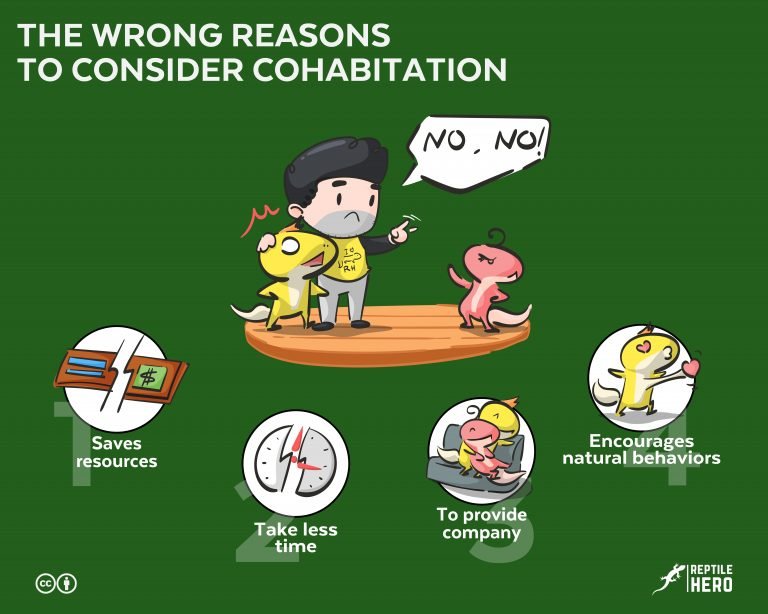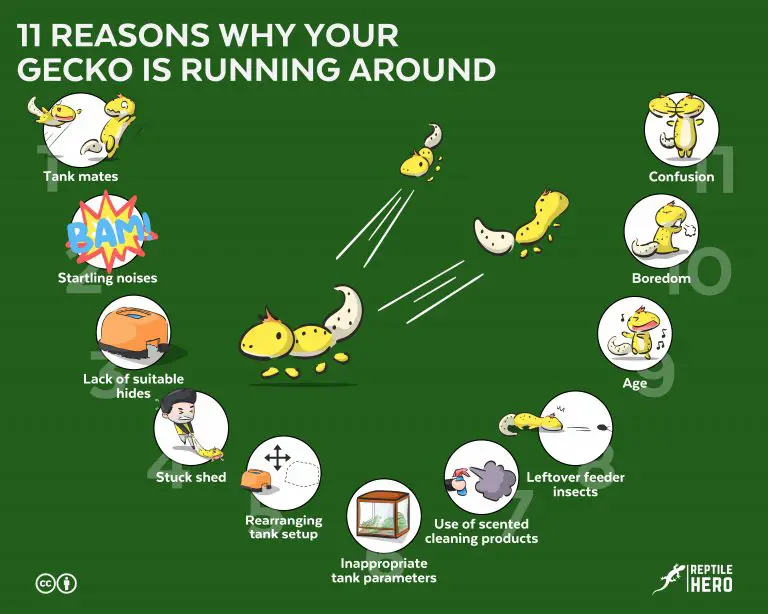Why Do Leopard Geckos Shake? (2 Types and Why They Do Them)
Shaking in leopard geckos—some people find it amusing, others think it’s deeply worrying! Indeed, leos may shake due to good or bad things. But can you easily tell normal shaking and problematic shaking apart by yourself?
Leopard geckos may display two types of shaking: clinical and normal. Clinical or pathological shaking in geckos can be a result of stress or symptom of an underlying condition such as metabolic bone disease and adenovirus. Normal shaking might happens while eating, for balancing purposes.
So what responsible owners should do is familiarize themselves with the common reasons why a leo would shake, shiver, or spasm. Otherwise, they may find themselves laughing at their wobbly and shaky geckos without realizing that they might be in danger! Scroll on and learn
8 Cases of Problematic Shaking in Leopard Geckos
When leopard geckos are constantly shaking or trembling, it is a symptom of a serious mental and/or physical problem. These tremors may be more noticeable when the gecko is moving. However, it may also be apparent even when a gecko stays stationary.
Your cute little soft-scaled gecko may suddenly get all shaky due to various health problems.
The cause may be something relatively easy to deal with like stress. But shaking and convulsions are telltale signs of deadly diseases!
1. Stress
The average leopard gecko will likely shake its tail and head when it is stressed. This might be triggered by internal and external factors such as a disease or a new enclosure respectively.
Aside from making warning calls and standing tall on all its feet, a leopard gecko commonly raises its tail and shakes it [1]. Your leo may slowly shake its tail sideways in a wave-like motion or it could twist it rather fast.
Geckos may also shake their heads up and down repeatedly in a considerably slow manner. This is typically shown by stressed geckos in aggressive encounters like when there is an intruder in its territory. Either way, shaking in such instances is no laughing matter.
Contrary to popular belief, tail shaking in aggression is not only done by male geckos but also female geckos!
Sadly, to an inexperienced reptile keeper, this may be viewed as geckos just being “weird” and “stupid” when in reality their pet geckos are likely extremely agitated. If you provoked it further, a highly distressed gecko may drop their tail.
Leopard geckos that have dropped their tails also require more care and attention as they need to build up fat and protein reserves in their body all over again. It can take a lot of time for the open wound alone to heal completely—about a month.
So if your gecko shakes its tail at you, don’t pick it up or force it to do anything. Just leave it alone. If it’s cohabbed, separate the other gecko. Otherwise, it may also spring into action and bite you or its cagemate.
Leopard Gecko With Mermaid Tails
Mermaid tails, as some keepers and breeders can them, are generally formed when a leopard gecko did not successfully drop its tail.

Here, a partial tear might be present in a gecko’s tail due to stress or shock. From there, a new tail will emerge and grow. When viewed side by side, the two tails form the shape of a mermaid or fish’s tail.
Other times, a gecko may experience the so-called “phantom drop.” In such cases, a gecko neither forms a tear nor drops in its tail, however, its tail will twitch as it would after dropping.
2. Regurgitation
A leopard gecko that has a blockage in its throat or is in the process of regurgitating will shake its head around repeatedly. Once the object or food item is no longer lodged in their throat, they will stop displaying seizure-like movements with their heads.
There are many reasons why leopard geckos may regurgitate including, but not limited to:
- Low temperatures
- Handling
- Overfeeding
- Over-sized prey
Learn more about regurgitation in our article on why geckos throw up.
I have also seen some geckos spit out strings of moss as well. But this can be easily avoided by cutting up moss so that our leos can safely pass it if they accidentally eat any.
Your gecko will flail its head around while opening and closing its mouth repeatedly to spit out whatever it is that it has ingested that’s now blocking its throats.
Owners that have witnessed their gecko’s regurgitation as being similar to seizures. For very bad cases of blockage, they will throw their heads back and forth which could result in even more injuries.
Besides these, you will likely notice that their throats are enlarged. So make sure to keep a close eye on your gecko if you suspect that it swallowed anything it won’t be able to pass easily.
3. Injury
Leopard geckos commonly shake their tail or limbs if they have sustained any injuries. Their twitching can be obvious even when there is no blood or open wound readily visible on their bodies.
When I hear other keepers talk about their leos shaking their legs while limping, the first thing I think of is foot injuries. Because as hardy as our precious geckos are, they aren’t invincible they can get hurt and wounded too.
Spinal or tail injuries can also cause the onset of twitching in geckos. This is mostly because geckos don’t have sticky toe pads like crested geckos, they are much more likely to fall and topple over, even while inside their tanks.
Now, newbies may think that the simple solution to this is to simply eliminate any tank decor or furnishing that leos can climb. However, doing this could cause more harm than good in the long run.
Learn more about the effects of keeping reptiles in sterile environments in our article on enrichment.
Instead, I would recommend designing your leopard gecko’s enclosure in a way that lets it safely climb and access elevated parts of its tanks. Having a thick loose substrate will also help prevent serious injuries from bad falls when they happen.
4. Metabolic Bone Disorder
Pronounced shaking and twitching in leopard gecko can be a symptom of metabolic bone disease or MBD. Generally, this is accompanied by unstable gait and walking as well. As the condition progresses, the gecko’s bones become brittle and they may develop permanent disability.
Years ago, it was quite common to see leopard geckos and many other pet reptiles with metabolic bone disease. They had severely misshapen spines and limbs and had short lives.
Thankfully though, more and more pet parents are becoming aware of how important it is to give their gecko supplements and UVB light like this one on Amazon. Many just thought was unnecessary for leos since they are not active throughout the day.
Nevertheless, it is still fairly common to see leos with really bent rubbery arms and rubbery jaws due to poor husbandry and health. Likely because the old myth of UVB being useless for crepuscular geckos persist to this day.
But as numerous experts have pointed out, pet geckos do not receive sufficient sunlight in captivity [2]. So to allow geckos to absorb calcium from their diet more easily, they need UVB tubes during the day.
Without UVB light, our leopard geckos are unable to create active vitamin D3 which is necessary for optimal calcium absorption. This, in turn, results in low calcium levels that can progress to severe cases of metabolic bone disease if left unaddressed.
Why do geckos twitch when they get the metabolic bone disease?
When geckos do not receive enough calcium, their nervous systems become highly reactive. This reactivity triggers nerves and sends impulses to various muscles, often in the limbs, that cause them to spasm and twitch. Scientists and veterinarians refer to this as tetany.
5. Enigma Syndrome
Leopard geckos may exhibit shaking in the form of head tremors and seizures due to Enigma Syndrome. This is a neurological condition that greatly affects their cognition and balance. However, this is only observed in leopard geckos that are an Enigma morph.
Since it only appears for Enigma morph leos, it is likely a result of genetic mutation from breeding.
Discover what other conditions are morph-specific in our article on leopard gecko morphs.
Other than shaking, the following symptoms are commonly seen in leopard geckos with Enigma Syndrome:
- Head tilting
- Star-gazing
- Circling
- Bad coordination
- Death rolls
- Hunting difficulties
But this doesn’t mean that only Enigmas can suffer from neurological problems. Other morphs may also develop such conditions due to other underlying problems including head trauma and overheating.
More importantly, having Enigma Syndrome doesn’t spell death for geckos. They can still live happy lives with their owner’s dedicated care and assistance.
6. Liver Problems
Various liver problems in leopard geckos can cause shaking and spasms. Although extremely rare, this can cause sudden death.
Honestly, I don’t have much to say about this reason since it is quite unusual and still poorly understood. I have personally ever only heard of such a case once, which did, unfortunately, end in death.
Oftentimes, it also co-occurs with a myriad of serious health problems as well. So whether the shaking is indeed caused by liver conditions alone or not is not yet known for sure.
Leopard geckos and other reptiles may have liver dysfunction as a result of:
- Infections
- Toxins
- Dehydration
- Medication
Nonetheless, experts have stated that liver conditions are one of many that can induce spasms and seizures in geckos [3].
Also, considering how big animals like cows can suddenly die after eating algae that are toxic to the liver, it shouldn’t be a surprise that our little geckos may experience a similar fate [4].
7. Kidney Failure
Shaking is a neurological symptom than can be observed in leopard geckos suffering from kidney failure. Oftentimes, this is caused by severe toxicity, poor husbandry, and improper diets.
I suspect that this is likely the case when I hear stories about healthy geckos suddenly just shaking all over and then dying. Because, unlike the earlier causes I mentioned, acute kidney failure can happen to seemingly healthy geckos [5].
At that, I would stress that though bioactive set-ups are great—I strongly advocate for it! But do your due diligence and always make sure that any live plant (here on Amazon) you add is safe for your gecko.
Check out which are safe options in our article on the best plants for leopard geckos.
Using the incident as I did earlier—if a gecko survives from eating a plant that is toxic there’s a chance that it may still survive. However, it’s more likely that the liver dysfunction it sustained may worsen and lead to kidney failure.
Once toxins have accumulated neurological signs such as spasms and inability to control movement manifest.
Now, of course, there are other signs of kidney disease that can help facilitate early detection and treatment. But the problem is that most gecko owners aren’t aware or familiar with them.
So what happens most of the time is a leo only gets medical attention when everything’s too late [6].
Below are common signs of kidney diseases in geckos and most reptiles:
- Sunken eyes
- Food refusal
- Foul breath
- Tissue death (necrosis)
- Lethargy
- Weakness
8. Adenovirus
Viral infections, specifically ones caused by Adenoviruses, can also cause shaking in leopard geckos. There is no vaccine for such an infection. However, Adenovirus infections are relatively rare in geckos and anti-viral medication for treatment exists.
Atadenovirus, in particular, infects geckos, lizards, birds, and even mammals [7]. It is highly resistant to environmental factors so it doesn’t mutate rapidly and frequently.
But it is nicknamed the “wasting disease” for a reason. In other words, just like Cryptosporidiosis, the odds of leopard geckos living happy and active lives after contracting Atadenovirus are very low. Moreover,
Adenovirus infections have been observed to not only affect the intestines liver, and kidneys, but also the gecko’s bone marrow and brain.
Symptoms of Adenovirus infection in leopard geckos include:
- Lethargy
- Anorexia
- Dehydration
- Vomiting
- Head tilting
- Circling
- Spams
- Chronic infections
The only good news I have regarding Adenovirus infection in geckos is that serious cases are rare in leopard geckos. Well, at least as far as I know.
Other species with documented cases of Adenovirus are fat-tail geckos and tokay geckos.
7 Cases of Normal Shaking in Leopard Geckos
Leopard gecko will naturally shake certain parts of its body, like its head or tail, in response to external stimuli such as encounters with prey and mating. In these cases, shaking is normal.
More often than not, leopard geckos will only shake a certain part of their body for a specific purpose. Other times, they may also seem as though their whole body is trembling.
Find out exactly what causes these different body shaking in gecko to rid yourself of worry!
1. Head-Shaking to Kill Prey
It is not uncommon for leopard geckos to shake their heads while eating live prey. They do this to either immobilize or kill their prey.
If you are still wondering why, well you can compare how we eat with how they eat.
Humans can easily eat our food as they are often already cut up into manageable pieces. Plus, our teeth are quite sharp and strong.
Conversely, our cute leos have rows or little teeth that don’t always effectively kill prey after they give their first bite.
So they may thrash their heads around to ensure that the prey is dead and won’t be able to fight back. I find that this is fairly common when they are fed hornworms
2. Head-Shaking to Swallow Prey
To swallow pray, leopard geckos typically shake their heads to ensure that they can completely consume their prey.
Such movements are normal and even help geckos in eating. They ordinarily shake their heads while they are still chomping on their kill.
But they can also do this after they have been able to fit the whole insect in their mouth.
3. Leg Shaking to Balance Themselves
A leopard gecko’s leg may shake while it’s slowly moving around to balance itself.
Unlike problematic leg shaking though, they usually only slightly shake their legs when walking about their tanks and exploring.
My friend sees her gecko having faint wobbling in its legs as well when it’s stalking its prey and doing its best not to get noticed by its target.
It could also happen when your leo inadvertently steps on something that has stuck to its toe. The gecko will shake it off to regain balanced steps.
4. Tail Shaking Due to Excitement
Owners have observed leopard geckos, especially juveniles, shake their tails when excited during feeding and hunting.
As a matter of fact, you’ll find multiple endearing videos of geckos doing this when they are served their favorite feeder or the occasional treat of wax worms.
Keep in mind as well, that some adult leos may still shake their tail enthusiastically when they are excited about feeding.
5. Tail-Shaking to Court Females
Male leopard geckos will shake their tails rapidly when courting females.
Geckos are very forward when it comes to courting. The male leo will simply rattle its tail when it sees a potential mate to attract it.
When the female accepts the offer, they will get right to it with the male nipping at the gecko’s back and neck. The guy may also shake his head and body while getting into position—frankly, it reminds me of how phones vibrate.
However, when a female responds by waving its tail, the offer is rejected. If the male leopard gecko continues pursuing, the lady leo may smack it with its tail and even deliver a nasty bite!
6. Body Shaking Due to Mating
The body of both male and female geckos tend to shake during mating.
Geckos aren’t all that subtle when they are doing the deed. It’s almost like the pair buzzes when they are in the act.
What’s more interesting, is that successful mating is signaled only when the female starts shivering—not just shaking.
But they don’t immediately separate after that. They may stay in that position for about 10 minutes before cleaning their own vents.
7. Body Shaking Due to the Cold
Though uncommon in leopard geckos, they have also been reported to shake their bodies when they get cold.
To be frank with you, this is actually something that I learned just recently. When I asked friends and acquaintances in the reptile community about this. It seems that not many are aware of this fact either—even experienced owners!
As we all know, leopard geckos usually just bask under the heat lamps in their tanks. They may lay out on their basking spots in the open or only partially expose their bodies, which is called cryptic basking.

But during, say, a blackout they may purposefully shake their bodies to generate even a little heat and keep themselves warm [8].
It’s quite similar to shivering in mammals, the difference is geckos, snakes, and other reptiles do it a lot less effective. In addition, doing so takes a lot of energy from reptiles.
So although it’s a perfectly natural response to cold, it’s best to be prepared for emergencies and have ways to keep your gecko warm. For instance, you could get a power bank like this one on Amazon.
Disclaimer!
There are probably more reasons behind shaking in geckos than I am aware of. But I did include all that I am aware of.
Please keep in mind that I am neither a herpetologist nor an exotic veterinarian. Despite sharing what I know about these topics, I can never beat their knowledge and expertise.
So if you suspect that your gecko may be suffering from any of the aforementioned conditions, please see a licensed and experienced veterinarian.
Further Questions
Is it normal for a gecko to shake when you move it slowly?
Despite being a common concern among new gecko owners, it is completely normal for geckos to shake subtly when they are moved slowly during handling sessions. The small movements allow them to stay upright even when they have no other support to grab on to.
Why do geckos suddenly jerk their leg?
A gecko may suddenly jerk their leg for no reason at all. It is quite common among all animals—even dogs, cats, and humans. Others also believe that they do this when they step on unfamiliar items, as when they walk on loose substrate for the first time. But leg jerking alongside tremors and spasms can be indicative of serious disorders.
Do geckos convulse when they are dying?
It is quite common for dying geckos to convulse as they die. This is initiated when parts of the brain that are responsible for breathing and the beating of the heart fail. Lack of air then triggers convulsing and violent spasms. Commonly, this is observed in euthanized geckos. However, this is an automatic reflex and is not felt by the animal.
What causes wheezing and spasm in geckos?
One of the causes of breathing spasms, which can be accompanied by wheezing sounds in geckos, is overheating. In inescapable environments with extremely high temperatures, death is highly likely.
Why is my snake shivering around its eggs?
Various snake species, including pythons, curl around their eggs and shiver around them. This is done to produce and maintain heat for the incubation of their clutch. Generally, this is only done when temperatures drop below what they deem optimal for the eggs. Female pythons can do this for up to 3 months.
Is it normal for a crested gecko to spasm after landing from a fall?
Contrary to circulating husbandry myths, it is normal for crested geckos to seemingly have spasms when they fall and land earlier than anticipated. It is not typically caused by seizures. Some have since called this behavior “falling spasms.” When slowly brought down while laying on their bellies, they perform similar actions.
Summary of 2 Why Do Leopard Geckos Shake?
Abnormal, erratic, and recurring shaking in leopard geckos is typically caused by health issues varying greatly in severity. More specifically, problematic shaking may be a sign of stress, regurgitation, injury, metabolic bone disease, neurological disorders, liver dysfunction, kidney failure, and adenovirus infection.
Conversely, temporary shaking may also be normal and functional behavior in geckos. Leopard geckos naturally shake their body—or certain parts of it—to kill prey, swallow food, balance themselves, show excitement, court potential mates, breed with a partner, and warm their bodies.
It may be difficult to properly differentiate between natural and pathological shaking in leopard geckos. So it is always recommended to seek the expert opinion of experienced reptile veterinary doctors when underlying health issues are suspected.
Sources
[2] https://aces.illinois.edu/news/pet-reptiles-need-vitamin-d-and-calcium-bone-health
[3] https://www.anapsid.org/spasms.html
[4] https://webapp.agron.ksu.edu/agr_social/m_eu_article.throck?article_id=1909
[5] https://www.dvm360.com/view/acute-and-chronic-renal-disease-reptiles-proceedings
[6] https://veterinarypartner.vin.com/default.aspx?pid=19239&catId=102919&id=8148630
[7] http://fwf.ag.utk.edu/mgray/ranavirus/2014Publications/Balletal2014.pdf
[8] https://cornerstone.lib.mnsu.edu/cgi/viewcontent.cgi?article=1745&context=etds


![What Do Gecko Eggs Look Like? [Size, Color, and More]](https://www.reptilehero.com/wp-content/uploads/2021/03/word-image-25-768x576.png)

![Why Do Leopard Geckos Poop in the Same Spot? [Wild Nature]](https://www.reptilehero.com/wp-content/uploads/2022/03/why-geckos-poop-in-one-spot-cc-1-768x614.jpg)

